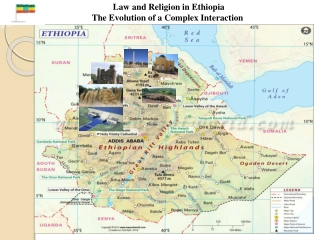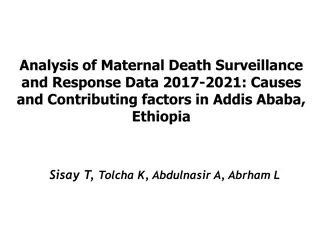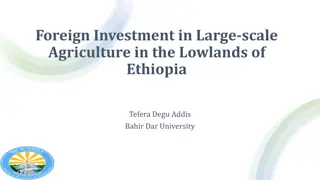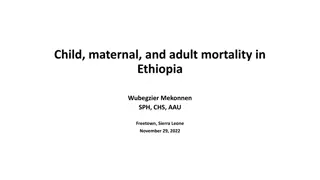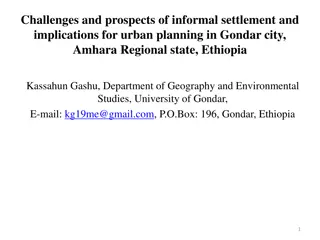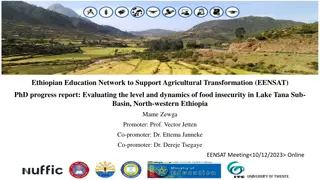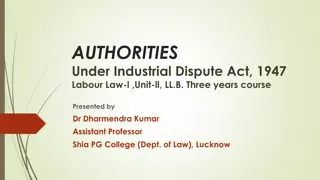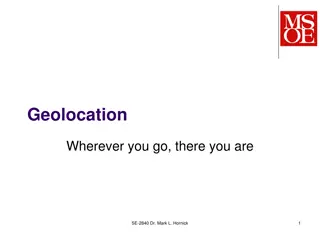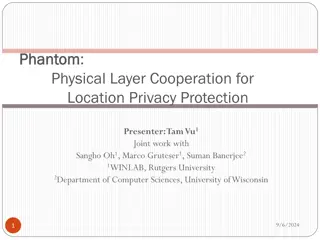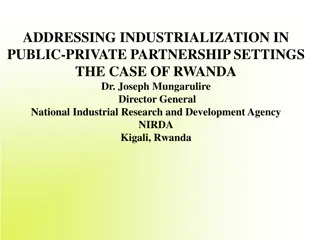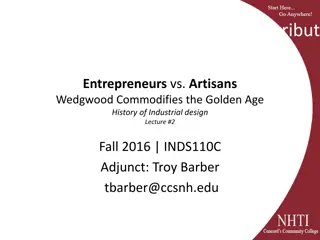Industrial Location Analysis and Trends in Ethiopia
Industrial location is crucial for firm performance, especially in Ethiopia where infrastructure lags behind. This chapter discusses determinants of industrial location, factors influencing factory setup decisions, and the role of economic, technical, and institutional factors. The analysis explores how industries select locations based on physical and economic conditions, with a focus on trends in Ethiopia.
Download Presentation

Please find below an Image/Link to download the presentation.
The content on the website is provided AS IS for your information and personal use only. It may not be sold, licensed, or shared on other websites without obtaining consent from the author. Download presentation by click this link. If you encounter any issues during the download, it is possible that the publisher has removed the file from their server.
E N D
Presentation Transcript
CHAPTER FOUR INDUSTRIAL LOCATION AND ANALYSIS 4.1. Introduction 4.2. Determinants of Industrial Location 4.3.Approaches to Industrial Location Analysis
After completing this lecture, you will be able to: identify the technical, economic and institutional factors that should be considered before setting up a factory examine how individual firms react in locating their factories under different physical and economic circumstances understand the industrial location trends in Ethiopia
Industrial location plays a vital role in the performance of a firm. In Ethiopia, since we are far behind in infrastructural matters than other developing countries, the place where an industry is located is one of the major determinants of its performance.
INTRODUCTION In setting up a factory a manufacturer has to take three interrelated decisions simultaneously: i. the scale of operation(Capacity) ii. the technique to be adopted which involves the selection of the appropriate combination of the factors of production, and iii. the location of the factory. The conventional theory of the firm provides the rules or norms for the first two types of decisions but it ignores the third one completely.
A separate branch of Economics bordering with the discipline of geography, which is known as 'industrial location' or 'locational analysis . It deals with the elements of the locatonal or spatial decision-making of industries In this unit we will study the theories of industrial location and see how they are operationally useful in deciding the best location for an economic activity. For example: A factory in the context of industrial economics.
4.2. DETERMINANTS OF INDUSTRIAL LOCATION A factory, with whose location analysis we are concerned in this unit, is a technical unit whose function is to convert a set of raw materials into some output with the help of men and machines, i.e., the factors of production. The raw materials and other inputs required by the factory for production will be rarely available at a place. The owners of the factory will have to procure them from different places which involve transportation and other procurement costs.
Similarly, the output of the factory will be rarely sold at a single place.i.e. It has to be sent to different places which again involve transportation and selling costs. Given the spatial distribution of the inputs and output markets, the owners of the factory will have to take the decision about the place where the factory should be located. All potential locations for the factory will not be equally economical. Only one of them is to be chosen which will be the most economical.
How to make the choice for this? The task of decision-making about industrial location is not very simple. A large number of technical, economic, and institutional factors are simultaneously. A manufacturer has to consider several technical, economic and institutional factors. A general list of such factors is given below. to be considered
A. Technical Factors These are the physical factors which are more or less geographical in nature related to soil, raw materials, people, climate, etc. The important factors in this category are: 1. Availability of land 2. Nature and quality of raw materials from land, eg. Forest products, agricultural inputs, minerals, and semi-finished products from existing industries. 3. Geographic situation of the factory site in relation to the transport facilities by rail, road, water and air. 4. Quantity and quality of human resources 5. Energy resources 6. Availability of water for drinking and industrial uses 7. Waste disposal facilities 8. Climate
B. Economic and Infrastructural Factors Input prices, taxes, markets, skills of labour forces, availability of adequate infrastructural facilities, finance, etc, constitute together the category of economic factors. The general list of factors for this would be as follows: Local markets Situation in relation to export markets Costs of land and buildings Costs of infrastructural facilities such as transport charges, power tariffs, water-rates, etc. Salaries and wages in relation to skills. Local cost of living Taxes and subsidies
Cost and availability of finance Structure of existing industries Industrial relations and trade union activities around the proposed location sites. Demographic factors such composition of local population, literacy, professional skills, etc. Local medical facilities Housing facilities Cultural facilities such as schools, clubs and other recreation centers. Communication facilities. as age and sex
C. Other factors All other miscellaneous location factors may be put in this category. Two of them are: Government policies towards location of new plants, and Personal factors Government policies: Most of the government pursue the policies of rapid industrialization of their states. They provide several facilities for locating new plants in some places or regions. An entrepreneur has to evaluate the facilities given by the government very carefully before taking a location decision of his factory.
Personal factors: also play important role in locational decision. A manufacturer may prefer to locate his factor at his birth place disregarding all economic factors. Industrial location based on such personal factors will entirely be a matter of chance or what is called as historical accident .
The weights assigned to individual factors depend on the prevailing circumstances and nature of the industry. In some industries firms are located near sources of major raw materials such as iron and steel, and pulp and paper, while in other industries they are located near markets. All factors together provide a spatial configuration which is to be analyzed very carefully for the optimum location of a factory. The choice of location will not be independent of the scale of production and the technique to be used. Some of the locational factors will be operative via their effect on the scale of production, some on the technique of production and some will be place-specific.
There approaches for locational analysis based on the above mentioned factors. They are however partial in nature in the sense that they take into account only a few major locational factors assuming all other factors are either constant or irrelevant. are several theoretical and applied
APPROACHES TO INDUSTRIAL LOCATIONAL ANALYSIS The theoretical material on industrial location is very much diversified. Significant contributions were made to it by geographers and the approaches however were different. The geographers, by and large, adopted intuitive conceptual base and case studies approach to arrive at some generalization about the industrial locational economists but their patterns.
The economists on the other hand, followed a more formal, abstract or deductive approach for locational analysis. An integration of these two diversified approaches led to develop some operational models for location studies. Some of the leading theoretical approaches to industrial locational analysis made by the people of the two disciplines are:
4.3.1. The Geographical Contributions The discipline of geography examines the form of the earth, its physical features, natural and political divisions, climate, production, and population, etc. Industries appearing on the earth's source do make some changes in its physical features and production patterns. Recognizing this fact, the geographers considered industrial location as a part of their discipline and we are trying to present a brief review of a few selected works having some theoretical relevance, they are The Central Place Theory Renner's theory Rawstron's Principle
4.3.1.1. The Central Place Theory This was the first systematic geographical theory of location. It was developed by Walter Christaller mainly to determine the number, size, and distribution of town and cities. Using certain simplified assumptions, Christaller was able to demonstrate geographically the spatial arrangement between places(service centers). In simplest terms, his theory proposed that towns with lowest level of specialization would be equally spaced and surrounded by hexagonally shaped hinterlands. hinterland and central
Although, empirical testing of this theory is doubtful yet it is regarded as valuable theoretical contribution in urban geography. It has relevance for location of a manufacturing industry in a special case where production tends to be centralized and the market is all really extended. The major limitation of this theory is that it fails to encompass the development of belts of industrial concentration and the agglomerative tendencies which are common features of the modern industrial structures.
4.3.1.2. Renners Theory The objective of Renner was to develop some general principles concerning industrial location. He classified industry extractive , reproductive , facilitative . To undertake any one of these six ingredients are required: raw materials, management, power, transportation(included in raw materials) Keeping in mind these postulated the law of location for fabricative (i.e., manufacturing) industry according to which any manufacturing industry tends to locate at a point which provides optimum access to its ingredients. into four fabricative , categories: and market, labour and and capital ingredients, Renner
It will, therefore, locate near to: a. Raw materials: if it uses perishable or highly condensable raw substances; or b. Market: Where the processing adds fragility, perishability, weight, or bulk to the raw materials, or where its products are subject to rapid changes in style, design, or technological character; or c. Power: Where the mechanical energy cost of processing are the chief items in the total cost; or d. Labour: where its wages to skilled workers are a large item/composotion on the total cost.
Apart from the above tendencies or laws, Renner gave a scheme for industrial symbiosis. There different types were mentioned for this: i. Disjunctive symbiosis: Where different industries having no organic i.e., economic or technical connections among themselves, gain advantages by existing together at a particular place. ii. Conjunctive symbiosis: where different industries with some organic connection among themselves (i.e., inter-connections) are located together and iii. Co-industrialization: which is an advance stage of the conjunctive symbiosis leading there by to a huge industrial belt of interconnected industries.
Renners approach on industrial location is quite realistic as it tries to bring together the major determinants. However, he has not been able to go deep in analyzing the effects of spatial cost variation and industrial symbiosis, i.e., agglomeration an on industrial location. He merely describes the tendencies of industrial location based on these factors.
4.3.1.3. Rawstrons Principle Rawstron has developed his theory of industrial location in terms of three restrictions which impede the choice of location for a factory. The restrictions are the principles of location in his model. These are: Physical restriction, Economic restriction, and Technical restriction. The physical restriction will be operative when some raw materials mainly natural resources are to be produced or procured at the proposed site for the plant.
The economic restriction embodies the concept of spatial margins to profitability. The cost of production, i.e. the sum of expenditure on labor, materials, land, marketing and capital, varies from place to place resulting in a spatial variation in profitability for a firm. Unlike most authors, Rawstron does not identify transport as a separate cost item but takes it as a factor for spatial variation in the cost of other items and hence of profitability. The sum of costs arising solely from the choice of location is defined as the location cost by Rawstron. It plays crucial role in locational decision making.
The technical restriction examines the effect of the level of technology on location. The decision on the choice of technique for production is one of the three interrelated decisions as we have mentioned earlier. So Rawstron's emphasis on technical restriction as location decisions is technology. In the case of changing technology it may be difficult to link the choice of plant location with the choice of technology since the latter is uncertain. consistent with stable
Generally, the effect of technological change is felt through some change in input requirement and hence on cost of production. Such change is taken into account by the second restriction in Rawstron's model. The emphasis on cost-structure for industrial location makes his approach more important than the other geographical studies on the subject of industrial location based on minimum transport cost.
4.3.2.The Economic Theories of Industrial Location The major theories of industrial location were developed by the economists. Some of them which we consider pioneering and useful in understanding the locational behavior of the firm are as follows: 4.3.2.1. Weber s Theory Alfred Weber, a German economist, has developed one of the earliest approaches to explain the location of manufacturing industry. Earlier to Weber, another German economist Launhardt has given a simple principle of industrial location based on minimum transport cost. Weber followed Launhardt s principle in his theory made it more rigorous and analytical. Ever since his theory is being used in practice.
Webers main interest was to construct a general theory of location which could be applied to all industries at all times. For this he has taken into account the general factors of location which were relevant to all industries. The factors considered by him were divided into two groups: i.Those influencing inter-regional industries (i.e., regional factors) and ii.Those influencing intra-regional location (i.e., agglomerating factors). location of
He regionally: raw material costs transport costs and labour costs. The fluctuations in raw material costs were however included within transport costs. The approach followed by weber was to explain industrial location in terms of transport cost first and then to examine the effects of changes in labour cost and agglomerative factors on it. found three general factors which vary
He made some simplifying assumptions for analysis such as: The locations of raw materials including fuel are fixed; Situation and size of consuming centers are given; and There are several fixed labour supply centers, labour is immobile and unlimited in supply at fixed wage rate.
Apart from these assumptions, Weber implicitly assumed the institutional factors like taxation, interest, insurance, etc are considered as insignificant locational factors. The economic culture and political system are treated to be uniform and stable across the locations. On the whole Weber assumed perfect competition for his mode.
Weber started his analysis with the proposition that a manufacturing unit tends to locate where the number of ton miles of raw materials and finished product to be moved per ton of product would be minimum. Weber used the locational triangle of Launhardt to find the place of minimum transport cost. He assumed a simple spatial situation in which there is only one consumption center (c) and two fixed supply centers (M1and M2) for two most important raw materials (see fig. 4.1)
There may be other consumption points and raw material supply centers but Weber did not consider all of them together. According to Weber, the least cost point will be located with in triangle CM1M2such as the one shown by P. The three corner points of the triangle will be pulling the location point (P) towards themselves. The position of the point will depend on the balance of the pulls exercised by them. If the pull of any one corner is greater than the sum of the pulls of the other corners, production will be located at the point or corner of origin of the dominant force.
The force exerted by each corner on production point is in the form of ton-mile weight to be moved from that point (M1 and M2) and to the point (C). Let x and y be the requirements of materials M1 and M2, in tons per ton of output and let one unit of output, i.e. finished product be transported from point P to C. The distances of the corner points from the production point (P) are unknown. Let them be a, b and c between P and M1, M2, and C points respectively.
The total ton-miles of transport per unit output would then be ax + by + c. This is to be minimized in order to find the position of point P, i.e. the location of production. An industry may be material-oriented or market- oriented from location point of view. Weber used the 'material index' for identifying such nature of the industry. The material index (M I) is defined as: MI= Weight of localized material/ Weight of finished product
Industries displaying material index than one i.e., MI > 1 are attracted towards the sources of raw materials such as iron and steel industry, Industries displaying a material index less than one i.e., MI < 1 are attracted towards the place of consumption(Market oriented). greater
The assumption of a uniform transportation rate, was relaxed by Weber by converting the weight to be transported into an ideal weight which is defined as a product (or a function) of actual weight and the rate of transportation cost, for a material or finished product. Let t1, t2and t3be the transportation rates per ton-mile for material M1, M2and finished product respectively, which is explained in the figure 4.1. The total transport cost per ton of finished product would be then equal to t1ax + t2by + t3c. The location of production point (P) within the triangle CM1M2can be determined now by minimizing this cost instead of the sum of ton-miles as mentioned earlier.
According to Weber an industry will choose a cheap labour site if the labour cost saving is greater than the increment in transport cost at this site above the minimum possible transport cost. Weber used the isodapanes to explain the effect of labor cost on the least-transport-cost location of a plant/factory. An isodapane is the locus of the points having equal additional transport cost around the least-transport cost location. There will be several isodapanes forming rings around the location fill different levels of incremental transport cost as shown in Fig. 4.2. Let P1be the least-transport-cost location and L1be a cheap labor site.
Further, let us presume that there will be a saving of labour cost by Birr. 4 if plant is located at L1instead of at P1. Should the location be shifted from P1to L1? For illustration, the isodapanes around P1are drawn for incremental transport cost of Birr.1, Birr. 2, Birr. 3, Birr. 4 and Birr.5. Point L1lies with in the isodapane of Birr. 4. It implies that it is economical to shift the location from P1to L1. If labor source making a saving production lie outside the isodapane of Birr. 4, such as shown by L2, it would mean a loss in shifting the location from the least-transport-cost location P1to the labour centre L2. of Birr. 4 in cost of
In general, let d1and d2be the total ton-miles of transport services per ton of product at P1and L1sites respectively, and let W1and W2be the hourly wage rates at these two sites respectively, h' is the number of man-hours required to produce one ton of product and 't' is the cost of transportation per ton-mile. The cost of production and transport at site P1would be (td1+W1h) and at site L1it would be (td2+ W2h). The cheap labor site (L1) would be chosen if (td1+W1h) > (td2+ W2h)Or (W1-W2) h > t (d2- d1) i.e., Saving in labour cost exceeds the increment in transportation cost.
To measure the importance of labour as a location factor, Weber used the average cost of labour per unit weight of product as an index. Greater the labour cost index more will be the industry's susceptibility to move from the least transport-cost site. Weber suggested to use the industry's coefficient of labor. This is defined as the labour cost per ton of location weight, where Location weight=Weight of material and product/Weight product = Material index (MI) + 1 A high coefficient of labour means a strong attraction to the cheap labour location.
4.3.2.2. The Market Area Theory of Tord Palander Tord Palander started his market area theory of industrial location analysis different but interrelated questions. Given the price and location of materials and the situation of the market, where will production take place? Given the place of production, the competitive conditions, factory costs, and transportation rates, how does price affect the extent of the area in which a particular producer can sell his goods? by posing two
To demonstrate how the market boundary between firms can be determined, Palander took a simple case of two firms making the same product and selling that in a linear market, which is depicted in figure. 4.3, the firms are located at two different places, A and B, which are on a horizontal line which defines the market area of the firms. Let the prices charged by the firms at their locations be and respectively. These are shown by the vertical distance AA' for firm A and BB' for firm B. The consumers who are situated away from the location points of the firms will be paying higher prices for the product of the firms.
The addition in price will be the transportation cost Let ta and tb be the average transport costs for the product per unit distance respectively. The price for the product at a point other than location would be + ta da for firm A and + tb db for firm B, da and db are the distances of the point from the location of firm A and firm B respectively. The transport cost is a function of distance for each firm. The gradients of total price paid by the consumer for the product are shown by the lines forming cones at points A' and B' for the two firms in Fig. 4.3. for the two firms
The gradients are linear because of fixed transport rates for the product over distance. Just above point X, the gradient lines of firm A and firm B intersect. This implies that consumers would be paying the same price for the product of the firms. The point X defines the boundary between the market areas of the two firms. Algebraically, at point X we have: + ta (AX) = + tb (BX) Since AX + XB =AB, i.e. the distance between the firm, we can therefore write + ta (AX) = + tb (AB-AX) Or AX = [( - )/ (ta+tb)] + [(tb)/ (ta+tb)]. AB



